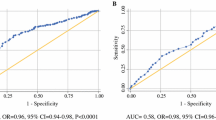Abstract
Nipple Aspirate Fluid (NAF) from patients with breast cancer is a potential source of exfoliated tumour material amenable to molecular biological study, but few such data have been reported. In this study we demonstrate that polymerase chain reaction (PCR) amplification of p53 gene DNA is achievable in a proportion of NAF samples from breast cancer patients. Subsequently four NAF samples from patients whose primary tumours were identified as having a defined p53 mutation were studied by single stranded conformational polymorphism analysis (SSCP). Two samples yielded PCR product indistinguishable from wild type and two yielded no product. Whilst no cancer-related genetic mutations were demonstrated in NAF samples, further study is warranted.
Similar content being viewed by others
References
Petrakis NL: Physiologic, biochemical, and cytologic aspects of nipple aspirate fluid. Breast Cancer Res Treat 8: 7–19, 1986
Wynder EL, Hill P: Prolactin, oestrogen and lipids in breast fluid. Lancet II: 840–842, 1977
Papanicolaou GN, Holmquist DG, Bader GM, Falk EA: Exfoliative cytology of the human mammary gland and its value in the diagnosis of cancer and other diseases of the breast. Cancer 11: 377–409, 1958
King EB, Chew KL, Petrakis NL, Ernster VL: Nipple Aspirate Cytology for the study of breast cancer precursors. J Natl Cancer Inst 71: 1115–1121, 1983
Sidransky D: Nucleic acid-based methods for the detection of cancer. Science 278: 1054–1058, 1997
Motomura K, Koyama H, Noguchi S, Inaji H, Azuma C: Detection of c-erbB-2 gene amplification in nipple discharge by means of polymerase chain reaction. Breast Cancer Res Treat 33: 89–92, 1994
Sartorius OW, Smith HS, Morris P, Benedict D, Friesen L: Cytologic evaluation of breast fluid in the detection of breast disease. J Natl Cancer Inst 59: 1073–1080, 1977
Orita M, Suzuki Y, Sekiya T, Hayashi K: Rapid and sensitive detection of point mutations and DNA polymorphisms using the polymerase chain reaction. Genomics 5: 874–879, 1989
Winship PR: An improved method for directly sequencing PCR amplified material using dimethyl sulphoxide. Nucleic Acids Res 17: 1266, 1989
Prosser J, Thompson AM, Granston G, Evans HJ: Evidence that p53 behaves as a tumour suppressor gene in sporadic breast tumours. Oncogene 5: 1573–1579, 1990
Kovach JS, McGovern RM, Cassady JD, Swanson SK, Wold LE, Vogelstein B, Sommer SS: Direct sequencing from touch preparations of human carcinoma: Analysis of p53 mutations in breast carcinomas. J Natl Cancer Inst 83: 1004–1009, 1991
Wu JK, Ye Z, Darras BT: Sensitivity of single-strand conformation polymorphism (SSCP) analysis in detecting p53 point mutations in tumours with mixed cell populations. Am J Hum Genet 52: 1273–1275, 1993
Phillips HA, Burns D, Prosser J, Howard GCW, Miller WR: Abstract: The sensitivity of single stranded conformational polymorphism in mutation detection in a mixed cell population. Br J Cancer 73 (XXV1): 45, 1996
Jacobson DR, Mills NE: A highly sensitive assay for mutant ras genes and its application to the study of presentation and relapse genotypes in acute leukaemia. Oncogene 9: 553–563, 1994
Rhodes CH, Hosinger C, Porter DM, Sorenson GD: Analysis of the allele-specific PCR method for the detection of neoplastic disease. Diagn Mol Pathol 6: 49–57, 1997
Sauter ER, Ross E, Daly M, Klein-Szanto, Engstrom PF, Sorling A, Malick J, Ehya H: Nipple aspirate fluid: a promising non-invasive method to identify cellular markers of breast cancer risk. Br J Cancer 76: 494–501, 1997
Crook T, Crossland S, Crompton MR, Osin P, Gusterson BA: p53 mutations in BRCA1-associated breast cancer. Lancet 350: 638–639, 1997
Gretarsdottir S, Thorlacius S, Valgarsdottir R, Gudlaugsdottir S, Sigurdsson S, Steinarsdottir M, Jonasson JG, Anamthawat-Jonsson K, Eyfjord JE: BRCA2 and p53 mutations in primary breast tumours in relation to genetic instability. Cancer Res 58: 859–862, 1998
Author information
Authors and Affiliations
Rights and permissions
About this article
Cite this article
Phillips, H.A., Howard, G.C. & Miller, W.R. Pilot studies on the p53 gene in nipple aspirate fluid from patients with breast cancer. Breast Cancer Res Treat 61, 139–143 (2000). https://doi.org/10.1023/A:1006487315587
Issue Date:
DOI: https://doi.org/10.1023/A:1006487315587




